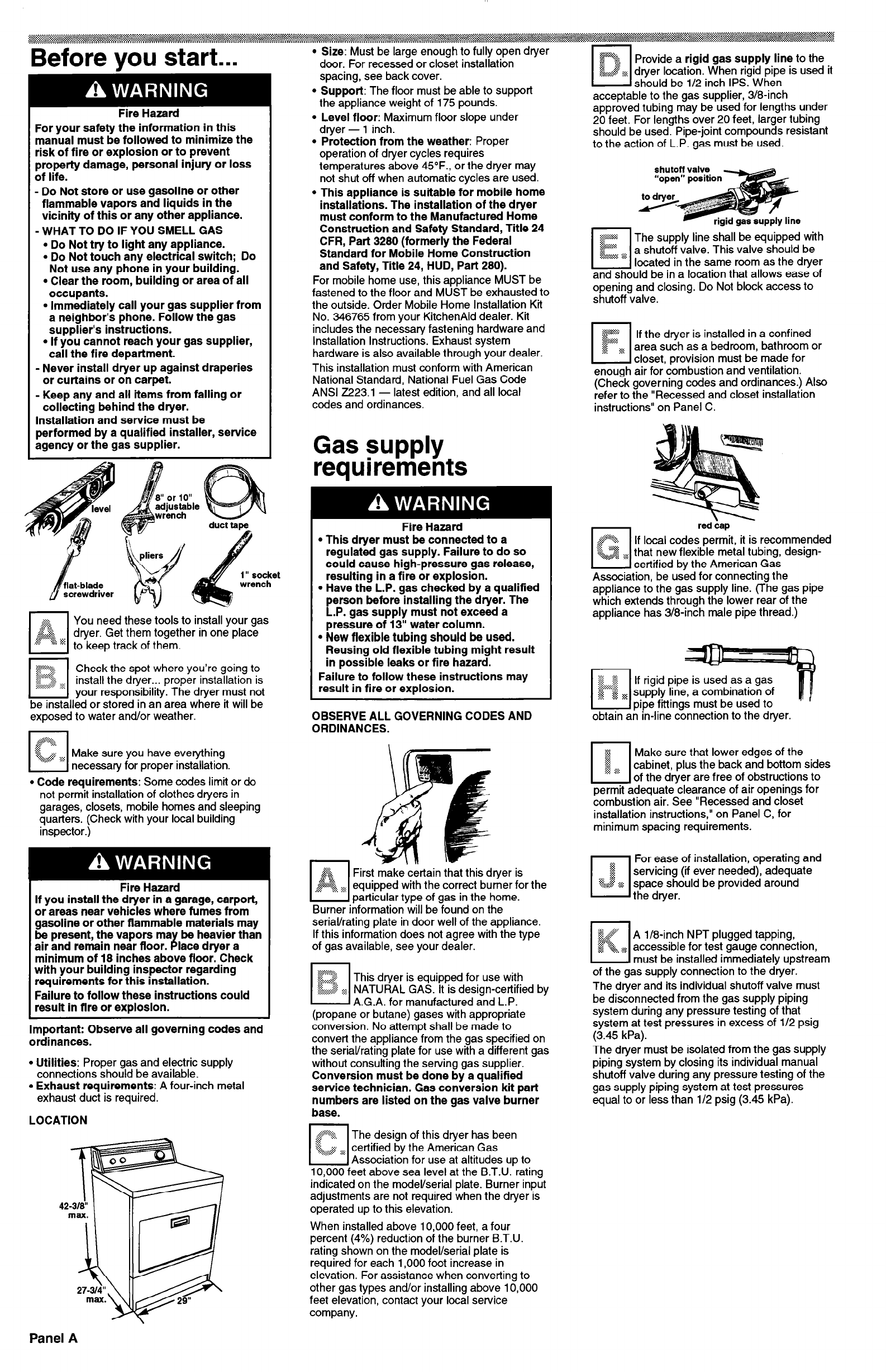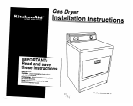
Before
you
start...
Fire Hazard
For your safety the information in this
manual must be followed to minimize the
risk of fire or explosion or to prevent
property damage, personal injury or loss
of life.
- Do Not store or use gasoline or other
flammable vapors and liquids in the
vicinity of this or any other appliance.
- WHAT TO DO IF YOU SMELL GAS
l
Do Not try to light any appliance.
l
Do Not touch any electrical switch; Do
Not use any phone in your building.
l
Clear the room, building or area of all
occupants.
l
Immediately call your gas supplier from
a neighbor’s phone. Follow the gas
supplier’s instructions.
l
If you cannot reach your gas supplier,
call the fire department.
- Never install dryer up against draperies
or curtains or on carpet.
- Keep any and all items from falling or
collecting behind the dryer.
Installation and service must be
performed by a qualified installer, service
agency or the gas supplier.
You need these tools to install your gas
dryer. Get them together in one place
to keep track of them.
gg:+
2 _ <$.
q
Check the spot where you’re going to
~~~f..-...-.:j:>
~~ _ c :.~: install the dryer... proper installation is
~~~~~~~~~~~X~~ ‘-.-. your responsibility. The dryer must not
be installed or stored in an area where it will be
exposed to water and/or weather.
h d
Make sure you have everything
necessary for proper installation.
l
Code requirements:
Some codes limit or do
not permit installation of clothes dryers in
garages, closets, mobile homes and sleeping
quarters. (Check with your local building
inspector.)
Fire Hazard
If you install the dryer in a garage, carport,
or areas near vehicles where fumes from
gasoline or other flammable materials may
be present, the vapors may be heavier than
air and remain near floor. Place dryer a
minimum of 18 inches above floor. Check
with your building inspector regarding
requirements for this installation.
Failure to follow these instructions could
result in fire or explosion.
Important: Observe all governing codes and
ordinances.
l
Utilities:
Proper gas and electric supply
connections should be available.
l
Exhaust requirements:
A four-inch metal
exhaust duct is required.
LOCATION
l
Size:
Must be large enough to fully open dyer
door. For recessed or closet installation
spacing, see back cover.
l
Support:
The floor must be able to support
the appliance weight of 175 pounds.
l
Level floor:
Maximum floor slope under
dyer - 1 inch.
l
Protection from the weather:
Proper
operation of dyer cycles requires
temperatures above 45”F., or the dyer may
not shut off when automatic cycles are used.
l
This appliance is suitable for mobile home
installations. The installation of the dryer
must conform to the Manufactured Home
Construction and Safety Standard, Title 24
CFR, Part 3280 (formerly the Federal
Standard for Mobile Home Construction
and Safety, Title 24, HUD, Part 280).
For mobile home use, this appliance MUST be
fastened to the floor and MUST be exhausted to
the outside. Order Mobile Home Installation Kit
No. 346765 from your KitchenAid dealer. Kit
includes the necessary fastening hardware and
Installation Instructions. Exhaust system
hardware is also available through your dealer.
This installation must conform with American
National Standard, National Fuel Gas Code
ANSI 2223.1 - latest edition, and all local
codes and ordinances.
Gas supply
requirements
Fire Hazard
l
This dryer must be connected to a
regulated gas supply. Failure to do so
could cause high-pressure gas release,
resulting in a fire or explosion.
l
Have the L.P. gas checked by a qualified
person before installing the dryer. The
L.P. gas supply must not exceed a
pressure of 13” water column.
l
New flexible tubing should be used.
Reusing old flexible tubing might result
in possible leaks or fire hazard.
Failure to follow these instructions may
result in fire or explosion.
OBSERVE ALL GOVERNING CODES AND
ORDINANCES.
t 1
*z.>
&.&
2J P
u
First make certain that this dyer is
jps$$ _
-’ ;.:.; :.:.:
equipped with the correct burner for the
particular type of gas in the home.
Burner information will be found on the
serial/rating plate in door well of the appliance.
If this information does not agree with the type
of gas available, see your dealer.
I I
. . . ..A...<....
p.2;.
:.:.> _ :<..
u
i:’ ::........ *..
This dyer is equipped for use with
.II .:.:.
:.:.:>>>x.:.. >...
_ . ..A
NATURAL GAS. It is design-certified by
A.G.A. for manufactured and L.P.
(propane or butane) gases with appropriate
conversion. No attempt shall be made to
convert the appliance from the gas specified on
the seriavrating plate for use with a different gas
without consulting the serving gas supplier.
Conversion must be done by a qualified
service technician. Gas conversion kit part
numbers are listed on the gas valve burner
base.
:@+.
::;g
0
The design of this dyer has been
j:.;
~5. :.:2 _ certified by the American Gas
I.:j..jv ~~,
Association for use at altitudes up to
10,000 feet above sea level at the B.T.U. rating
indicated on the model/serial plate. Burner input
adjustments are not required when the dyer is
operated up to this elevation.
When installed above 10,000 feet, a four
percent (4%) reduction of the burner B.T.U.
rating shown on the model/serial plate is
required for each 1,000 foot increase in
elevation. For assistance when converting to
other gas types and/or installing above 10,000
feet elevation, contact your local service
company.
u
p: Provide a
rigid gas supply.line
to the
r
+&z+ dyer location. When rigid pipe IS used it
should be l/2 inch IPS. When
acceptable to the gas supplier, 3/8-inch
approved tubing may be used for lengths under
20 feet. For lengths over 20 feet, larger tubing
should be used. Pipe-joint compounds resistant
to the action of L.P. gas must be used.
shutoff valve
4
:.:i=
.I
u
$jjjj:
The supply line shall be equipped with
&..j .s;
a shutoff valve. This valve should be
located in the same room as the dyer
and should be in a location that allows ease of
opening and closing. Do Not block access to
shutoff valve.
;,g$$$;s
0
&<$
If the dyer is installed in a confined
2;
E area such as a bedroom, bathroom or
..s.
closet, provision must be made for
enough air for combustion and ventilation.
(Check governing codes and ordinances.) Also
refer to the “Recessed and closet installation
instructions” on Panel C.
red cap
If local codes permit, it is recommended
that new flexible metal tubing, design-
certified by the American Gas
Association, be used for connecting the
appliance to the gas supply line. (The gas pipe
which extends through the lower rear of the
appliance has 3/8-inch male pipe thread.)
If rigid pipe is used as a gas
supply line, a combination of
pipe fittings must be used to
obtain an in-line connection to the dyer.
y<
0
$$
Make sure that lower edges of the
;gj E:
cabinet, plus the back and bottom sides
of the dyer are free of obstructions to
permit adequate clearance of air openings for
combustion air. See “Recessed and closet
installation instructions,” on Panel C, for
minimum spacing requirements.
For ease of installation, operating and
servicing (if ever needed), adequate
space should be provided around
the dyer.
Ai
&$+.
0
A l/8-inch NPT plugged tapping,
Pg. s accessible for test gauge connection,
must be installed immediately upstream
of the gas supply connection to the dyer.
The dyer and its individual shutoff valve must
be disconnected from the gas supply piping
system during any pressure testing of that
system at test pressures in excess of l/2 psig
(3.45 kPa).
The dyer must be isolated from the gas supply
piping system by closing its individual manual
shutoff valve during any pressure testing of the
gas supply piping system at test pressures
equal to or less than l/2 psig (3.45 kPa).
Panel A







